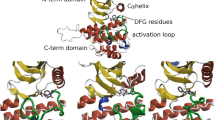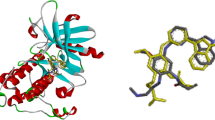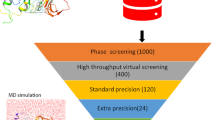Abstract
The structural diversity observed across protein kinases, resulting in subtly different active site cavities, is highly desirable in the pursuit of selective inhibitors, yet it can also be a hindrance from a structure-based design perspective. An important challenge in structure-based design is to better understand the dynamic nature of protein kinases and the underlying reasons for specific conformational preferences in the presence of different inhibitors. To investigate this issue, we performed molecular dynamics simulation on both the active and inactive wild type epidermal growth factor receptor (EGFR) protein with both type-I and type-II inhibitors. Our goal is to better understand the origin of the two distinct EGFR protein conformations, their dynamic differences, and their relative preference for Type-I inhibitors such as gefitinib and Type-II inhibitors such as lapatinib. We discuss the implications of protein dynamics from a structure-based design perspective.






Similar content being viewed by others
Abbreviations
- EGFR:
-
Epidermal growth factor receptor
- G-loop:
-
Glycine-rich loop
- A-loop:
-
Activation loop
- R-spine:
-
Regulatory spine
- H-cluster:
-
Hydrophobic cluster
- DFG motif:
-
Asp-Phe-Gly conserved motif
- HRD motif:
-
His-Arg-Asp conserved motif
- PDB:
-
Protein data bank
- MD:
-
Molecular dynamics
- RMSD:
-
Root average square deviation
- RMSF:
-
Root average square fluctuation
- SD:
-
Standard deviation
References
Zuccotto F, Ardini E, Casale E, Angiolini M (2009) Through the “Gatekeeper Door”: exploiting the active kinase conformation. J Med Chem 53:2681–2694
Weinmann H, Metternich R (2005) Editorial: drug discovery process for kinease inhibitors. Chem Bio Chem 6:455–459
Stamos J, Sliwkowski MX, Eigenbrot C (2002) Structure of the epidermal growth factor receptor kinase domain alone and in complex with a 4-anilinoquinazoline inhibitor. J Biol Chem 277:46265–46272
Wood ER, Truesdale AT, McDonald OB, Yuan D, Hassell A, Dickerson SH, Ellis B, Pennisi C, Horne E, Lackey K, Alligood KJ, Rusnak DW, Gilmer TM, Shewchuk L (2004) A unique structure for epidermal growth factor receptor bound to GW572016 (Lapatinib). Cancer Res 64:6652–6659
Yun CH, Boggon TJ, Li Y, Woo MS, Greulich H, Meyerson M, Eck MJ (2007) Structures of lung cancer-derived EGFR mutants and inhibitor complexes: mechanism of activation and insights into differential inhibitor sensitivity. Cancer Cell 11:217–227
Kornev AP, Haste NM, Taylor SS, Ten Eyck LF (2006) Surface comparison of active and inactive protein kinases identifies a conserved activation mechanism. Proc Natl Acad Sci USA 103:17783–17788
Papakyriakou A, Vourloumis D, Tzortzatou-Stathopoulou F, Karpusas M (2009) Conformational dynamics of the EGFR kinase domain reveals structural features involved in activation. Proteins 76:375–386
Zhang X, Gureasko J, Shen K, Cole PA, Kuriyan J (2006) An allosteric mechanism for activation of the kinase domain of epidermal growth factor receptor. Cell 125:1137–1149
Liu Y, Gray NS (2006) Rational design of inhibitors that bind to inactive kinase conformations. Nat Chem Biol 2:358–364
Liao JJL (2007) Molecular recognition of protein kinase binding pockets for design of potent and selective kinase inhibitors. J Med Chem 50:409–424
Manning G, Whyte DB, Martinez R, Hunter T, Sudarsanam S (2002) The protein kinase complement of the human genome. Science 298:1912–1934
Schindler T, Bornmann W, Pellicena P, Miller WT, Clarkson B, Kuriyan J (2000) Structural mechanism for STI-571 inhibition of abelson tyrosine kinase. Science 289:1938–1942
Tong L, Pav S, White DM, Rogers S, Crane KM, Cywin CL, Brown ML, Pargellis CA (1997) A highly specific inhibitor of human p38 MAP kinase binds in the ATP pocket. Nat Struct Biol 4:311–316
Bikker JA, Brooijmans N, Wissner A, Mansour TS (2009) Kinase domain mutations in cancer: implications for small molecule drug design strategies. J Med Chem 52:1493–1509
Liu B, Bernard B, Wu JH (2006) Impact of EGFR point mutations on the sensitivity to gefitinib: insights from comparative structural analyses and molecular dynamics simulations. Proteins 65:331–346
Balius TE, Rizzo RC (2009) Quantitative prediction of fold resistance for inhibitors of EGFR. Biochemistry 48:8435–8448
Wan S, Coveney PV (2011) Rapid and accurate ranking of binding affinities of epidermal growth factor receptor sequences with selected lung cancer drugs. J R Soc Interface 8:1114–1127
Wan S, Coveney PV (2011) Molecular dynamics simulation reveals structural and thermodynamic features of kinase activation by cancer mutations within the epidermal growth factor receptor. J Comput Chem 32:2843–2852
Amadasi A, Surface JA, Spyrakis F, Cozzini P, Mozzarelli A, Kellogg GE (2008) Robust classification of “relevant” water molecules in putative protein binding sites. J Med Chem 51:1063–1067
Barillari C, Taylor J, Viner R, Essex JW (2007) Classification of water molecules in protein binding sites. J Am Chem Soc 129:2577–2587
Treesuwan W, Hannongbua S (2009) Bridge water mediates nevirapine binding to wild type and Y181C HIV-1 reverse transcriptase—evidence from molecular dynamics simulations and MM-PBSA calculations. J Mol Graph Model 27:921–929
Santos R, Hritz J, Oostenbrink C (2009) Role of water in molecular docking simulations of cytochrome P450 2D6. J Chem Info Model 50:146–154
Huang N, Shoichet BK (2008) Exploiting ordered waters in molecular docking. J Med Chem 51:4862–4865
Šali A, Blundell TL (1993) Comparative protein modelling by satisfaction of spatial restraints. J Mol Biol 234:779–815
Laskowski RA, MacArthur MW, Moss DS, Thornton JM (1993) PROCHECK: a program to check the stereochemical quality of protein structures. J Appl Crystallogr 26:283–291
Hornak V, Abel R, Okur A, Strockbine B, Roitberg A, Simmerling C (2006) Comparison of multiple Amber force fields and development of improved protein backbone parameters. Proteins 65:712–725
Sousa da Silva AW, Vranken WF (2012) ACPYPE—AnteChamber PYthon Parser interfacE. BMC Res Notes 5:367
Wang J, Wolf RM, Caldwell JW, Kollman PA, Case DA (2004) Development and testing of a general amber force field. J Comput Chem 25:1157–1174
Wang J, Wang W, Kollman PA, Case DA (2006) Automatic atom type and bond type perception in molecular mechanical calculations. J Mol Graph Model 25:247–260
Van der Spoel D, Lindahl E, Hess B, Groenhof G, Mark AE, Berendsen HJC (2005) GROMACS: fast, flexible, and free. J Comput Chem 26:1701–1718
Hess B, Kutzner C, van der Spoel D, Lindahl E (2008) GROMACS 4: algorithms for highly efficient, load-balanced, and scalable molecular simulation. J Chem Theor Comput 4:435–447
Sorin EJ, Pande VS (2005) Exploring the helix-coil transition via all-atom equilibrium ensemble simulations. Biophys J 88:2472–2493
DePaul AJ, Thompson EJ, Patel SS, Haldeman K, Sorin EJ (2010) Equilibrium conformational dynamics in an RNA tetraloop from massively parallel molecular dynamics. Nucleic Acids Res 38:4856–4867
Berendsen HJC, Postma JPM, van Gunsteren WF, DiNola A, Haak JR (1984) Molecular dynamics with coupling to an external bath. J Chem Phys 81:3684–3690
Hess B, Bekker H, Berendsen HJC, Fraaije JGEM (1997) LINCS: a linear constraint solver for molecular simulations. J Comput Chem 18:1463–1472
Darden T, York D, Pedersen L (1993) Particle mesh Ewald: An N • log(N) method for Ewald sums in large systems. J Chem Phys 98:10089–10092
Essmann U, Perera L, Berkowitz ML, Darden T, Lee H, Pedersen LG (1995) A smooth particle mesh Ewald method. J Chem Phys 103:8577–8593
Åqvist J, Medina C, Samuelsson JE (1994) A new method for predicting binding affinity in computer-aided drug design. Protein Eng 7:385–391
Hansson T, Marelius J, Åqvist J (1998) Ligand binding affinity prediction by linear interaction energy methods. J Comput Aided Mol Des 12:27–35
Wallace AC, Laskowski RA, Thornton JM (1995) LIGPLOT: a program to generate schematic diagrams of protein-ligand interactions. Protein Eng 8:127–134
Acknowledgments
This work was supported by the Higher Education Research Promotion and National Research University Project of Thailand, Office of the Higher Education Commission and the Thailand Research Fund grants RMU5180032 (KC) and RSA5480016 (MPG). We wish to express our gratitude for the use of Laboratory for Computational and Applied Chemistry (LCAC) research facilities at Kasetsart University provided by the National Center of Excellence in Petroleum, Petrochemical Technology and Advanced Materials. M.P.G. is grateful for the support of the Faculty of Science at KU and Associate Professor Supa Hannongbua in particular. N.S. was supported by a grant under the program Strategic Scholarships for Frontier Research Network for the Join PhD Program Thai Doctoral degree from the Office of the Higher Education Commission, Ministry of Education, Thailand.
Author information
Authors and Affiliations
Corresponding authors
Electronic supplementary material
Below is the link to the electronic supplementary material.
ESM 1
(DOC 9767 kb)
Rights and permissions
About this article
Cite this article
Songtawee, N., Gleeson, M.P. & Choowongkomon, K. Computational study of EGFR inhibition: molecular dynamics studies on the active and inactive protein conformations. J Mol Model 19, 497–509 (2013). https://doi.org/10.1007/s00894-012-1559-0
Received:
Accepted:
Published:
Issue Date:
DOI: https://doi.org/10.1007/s00894-012-1559-0




